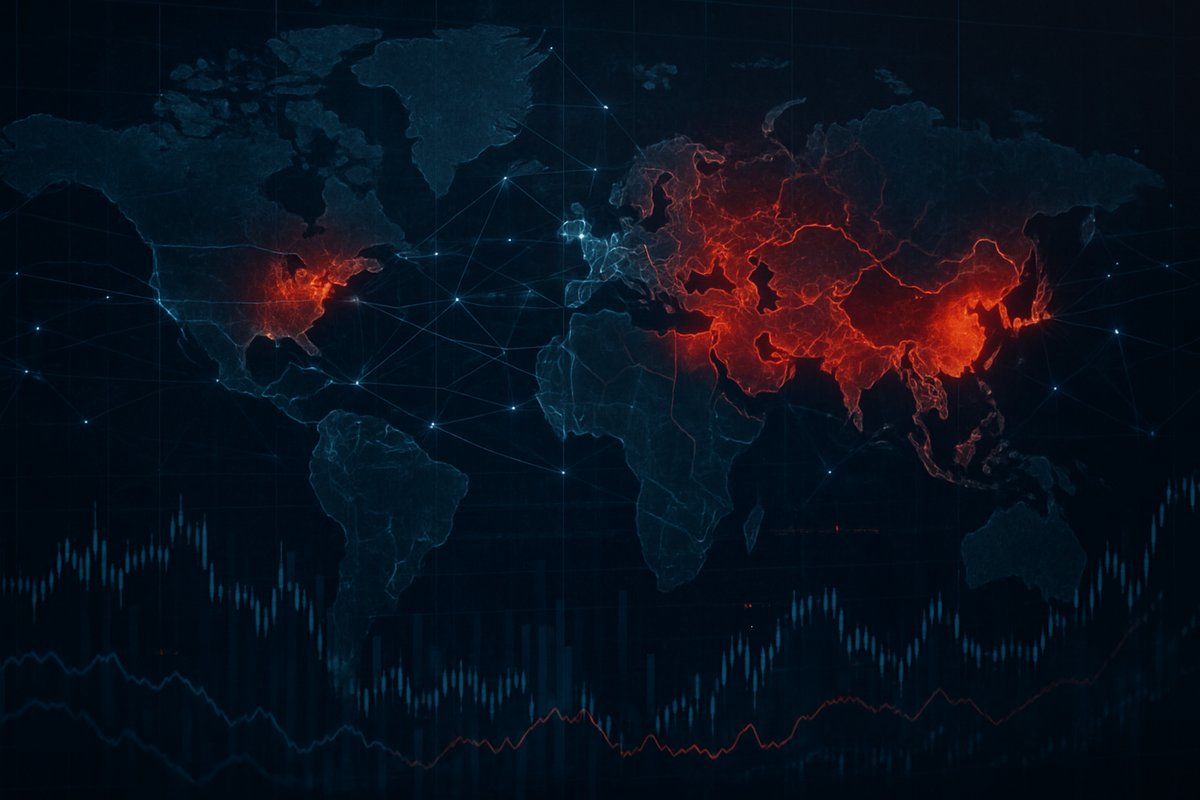Geopolitical Headwinds: How Global Instability is Shaping Investor Sentiment and Asset Prices

The global financial landscape is currently navigating a turbulent sea of geopolitical risks, with ongoing conflicts, escalating diplomatic tensions, and the pervasive threat of cyberattacks casting long shadows over investor sentiment and asset prices. These multifaceted challenges are not merely isolated incidents but rather interconnected forces that contribute to heightened market volatility, disrupt established trade routes, and reconfigure investment strategies worldwide. The immediate implications are clear: a pervasive sense of uncertainty that compels investors to re-evaluate risk, seek safe havens, and brace for potential economic shocks.
From the protracted conflict in Ukraine to simmering tensions in the Middle East and the ever-present specter of cyber warfare, these geopolitical headwinds are creating a complex and unpredictable environment. The ripple effects are felt across various asset classes, influencing everything from commodity prices and equity valuations to bond yields and currency fluctuations. Understanding the intricate interplay of these factors is crucial for investors seeking to navigate the current market landscape and position themselves for future opportunities and challenges.
A World on Edge: Unpacking the Drivers of Market Volatility
The current surge in global geopolitical risks stems from a confluence of factors, each contributing to a climate of uncertainty that profoundly impacts financial markets. The most prominent among these are ongoing military conflicts, a web of intricate diplomatic tensions, and the escalating and increasingly sophisticated threat of cyberattacks.
The Russia-Ukraine conflict, which began in February 2022, remains a significant destabilizing force. The initial invasion triggered an immediate and sharp global market response, with European bank equities plummeting over 20% and widespread negative abnormal returns across global stock markets. Energy and food prices surged due to disruptions in critical supply chains and blockades of Black Sea ports. While defense stocks saw a boost, technology and growth stocks experienced declines as capital shifted towards perceived "safer" assets. As of August 2025, the conflict persists, with ongoing fighting and drone attacks on Russian energy infrastructure, further straining global supply chains. Despite initial sharp sell-offs, stock markets have demonstrated a degree of resilience, often recovering as the situation stabilizes or the conflict's scope becomes clearer.
Simultaneously, Middle East conflicts, particularly those involving Israel and Iran, and the ongoing Israel-Hamas conflict, frequently inject volatility into oil markets. Oil prices rose at the onset of the Israeli-Hamas conflict and again during the Israel-Iran conflict, though these spikes were generally short-lived compared to the initial surge seen during the Ukraine war. A broader regional conflict, however, could have a more severe and sustained impact, especially on oil and other commodity prices. Recent optimism surrounding an Israel-Iran ceasefire, for instance, led to gains in some stock markets, such as India's BSE Sensex and Nifty. Generally, wars induce investor fear, leading to sell-offs and heightened volatility in equity markets, with investors often seeking refuge in "safe-haven" assets like gold and government bonds. Emerging market stocks are disproportionately affected, experiencing an average monthly drop of 5 percentage points during international military conflicts.
Beyond direct military engagements, diplomatic tensions and policy shifts between major global powers also contribute significantly to market uncertainty. The US-China trade tensions, marked by tariffs exceeding 100% on Chinese goods, have led to a significant reconfiguration of global supply chains and a reduction in U.S. investments in China. These tariff fluctuations symbolize the delicate balance in international trade relations, and while temporary suspensions have occurred, the overall landscape remains complex and subject to ongoing recalibration. Upcoming tariff deadlines, such as the July 9 U.S.-EU deadline, further contribute to investor caution and potential market volatility. Concerns regarding the accuracy of economic data and the independence of the Federal Reserve, particularly in the face of potential political interference, could amplify market volatility and erode confidence in U.S. monetary policy. While media attention on geopolitical risk may seem intense, measures like the Geopolitical Risk Index (GPR) indicate that overall risk levels are only slightly above the long-term baseline. However, elevated political polarization increases the potential for rapid escalation of events, with major spikes in the GPR primarily associated with outbreaks of war, such as the 2022 Russian invasion of Ukraine and Chinese military maneuvers around Taiwan in 2023.
Finally, the threat of cyberattacks poses an unprecedented and growing systemic risk to global financial stability. Financial institutions are targeted significantly more than other industries, experiencing up to 300 times more cyberattacks annually, with a 25% year-on-year increase in intrusion events for 2024. AI-enhanced attacks, credential theft, and supply chain vulnerabilities are major concerns. In 2024, nearly 97% of major U.S. banks and 100% of Europe's top financial firms experienced third-party breaches, highlighting weaknesses in vendor ecosystems. Phishing remains a prevalent threat, with tests showing that almost 45% of employees in large financial institutions are susceptible to clicking malicious links. Ransomware attacks, led by groups like Cl0p, LockBit 3.0, and BlackCat, continue to be a significant danger. Cyberattacks can disrupt market operations, compromise sensitive data, and undermine investor confidence. A single day's disruption in payments by major banks could impact up to 38% of network banks globally. The financial costs of data breaches are substantial and rising, with the global average reaching $4.88 million in 2024. Recent high-profile incidents include a 2023 attack on the U.S. arm of China's largest bank, Industrial and Commercial Bank of China (ICBC) (HKG: 1398), which temporarily disrupted trades in the U.S. Treasury market, and a May 2025 Coinbase (NASDAQ: COIN) breach that exposed sensitive data of nearly 70,000 account holders, incurring estimated costs of $180-400 million.
Navigating the Shifting Sands: Winners and Losers in a Volatile World
The current geopolitical landscape creates a distinct set of winners and losers within the financial markets, as investors reallocate capital in response to heightened risks and evolving global dynamics. Companies and sectors that offer stability, essential goods, or enhanced security are likely to thrive, while those heavily reliant on global supply chains, international trade, or stable geopolitical relations may face significant headwinds.
Defense contractors are clear beneficiaries of increased global instability. As nations bolster their military capabilities in response to perceived threats, companies like Lockheed Martin (NYSE: LMT), Raytheon Technologies (NYSE: RTX), and Northrop Grumman (NYSE: NOC) are likely to see increased demand for their products and services. The ongoing Russia-Ukraine conflict, for instance, has already led to significant increases in defense spending across Europe and beyond, translating into robust order backlogs and strong financial performance for these firms. Similarly, cybersecurity firms are experiencing a surge in demand as the threat of cyberattacks intensifies. Companies such as CrowdStrike (NASDAQ: CRWD), Palo Alto Networks (NASDAQ: PANW), and Zscaler (NASDAQ: ZS) are at the forefront of protecting critical infrastructure and sensitive data, making their services indispensable in the current environment. The rising financial costs of data breaches and the increasing sophistication of attacks underscore the critical need for advanced cybersecurity solutions.
Conversely, companies with extensive global supply chains and those heavily reliant on international trade are particularly vulnerable. Manufacturers that source components from multiple countries, especially those involved in geopolitical hotspots, face disruptions, increased costs, and potential delays. Companies like Apple (NASDAQ: AAPL), which has a vast and complex global supply chain, are actively seeking to diversify their manufacturing base to mitigate these risks. Similarly, multinational corporations with significant operations or sales in regions affected by conflicts or diplomatic tensions may experience reduced demand, operational challenges, and increased regulatory scrutiny. The US-China trade tensions, for example, have forced many companies to re-evaluate their market strategies and consider reshoring or nearshoring production.
Furthermore, emerging market stocks are disproportionately affected by international military conflicts, experiencing an average monthly drop of 5 percentage points. This is due to their higher perceived risk, greater sensitivity to global capital flows, and often less diversified economies. Investors tend to pull capital from these markets during times of uncertainty, seeking safer havens. Companies operating primarily in these regions, or those with significant exposure to emerging markets, may therefore face greater volatility and downward pressure on their valuations. The energy sector, while experiencing price surges during conflicts, also faces significant uncertainty due to potential supply disruptions and the long-term shift towards renewable energy, which could be accelerated or decelerated by geopolitical events.
Industry Impact and Broader Implications: A Reshaping of the Global Economy
The current geopolitical landscape is not merely causing short-term market fluctuations; it is fundamentally reshaping industry trends, creating ripple effects across various sectors, and prompting significant regulatory and policy considerations. This era of elevated risk is forcing a re-evaluation of global interconnectedness and a renewed focus on resilience and self-sufficiency.
One of the most significant broader implications is the reconfiguration of global supply chains. The US-China trade tensions and the Russia-Ukraine conflict have exposed the vulnerabilities of highly optimized, just-in-time supply chains. Companies are now actively pursuing strategies of "de-risking" and "friend-shoring," seeking to diversify their sourcing and manufacturing to politically aligned or geographically closer nations. This trend will likely benefit countries with stable political environments and robust manufacturing capabilities, potentially leading to a resurgence of domestic production in some regions. For instance, companies like Samsung (KRX: 005930) and Intel (NASDAQ: INTC) are investing heavily in new fabrication plants in the US and Europe, driven by both geopolitical concerns and government incentives. This shift will have profound implications for logistics, transportation, and manufacturing industries globally.
The heightened geopolitical risks also accelerate the digital transformation and cybersecurity investments across all industries. As cyberattacks become more sophisticated and frequent, businesses are compelled to invest heavily in robust cybersecurity infrastructure and talent. This creates a booming market for cybersecurity providers and IT service companies. Beyond the financial sector, critical infrastructure, energy grids, and government agencies are all increasing their defenses, recognizing the systemic threat posed by state-sponsored and criminal cyber actors. This trend is likely to continue, making cybersecurity a non-negotiable aspect of business operations and national security.
From a regulatory and policy perspective, governments are increasingly intervening to protect national interests and critical industries. This includes imposing tariffs, implementing export controls, and offering subsidies to strategic sectors. The CHIPS and Science Act in the US, aimed at boosting domestic semiconductor manufacturing, is a prime example of such policy intervention driven by geopolitical competition. These policies can create both opportunities and challenges for businesses, depending on their alignment with national priorities. Furthermore, the independence of central banks, particularly the Federal Reserve, is under scrutiny, with concerns that political interference could erode confidence in monetary policy and amplify market volatility.
Historically, periods of elevated geopolitical tension have often led to significant shifts in global power dynamics and economic structures. The Cold War, for instance, spurred technological innovation and the formation of new economic blocs. While the current situation is distinct, the emphasis on national security, economic resilience, and technological sovereignty echoes similar historical precedents. The current environment suggests a move away from unfettered globalization towards a more fragmented and regionalized global economy, with increased protectionism and strategic competition. This could lead to a more complex and less efficient global trading system, but also potentially more resilient national economies.
What Comes Next: Navigating the Future of Global Instability
The path forward in this era of elevated geopolitical risk is fraught with both challenges and opportunities, demanding strategic pivots and adaptive approaches from investors and businesses alike. The short-term outlook suggests continued volatility, while the long-term trajectory points towards a more fragmented and security-conscious global economy.
In the short term, investors should anticipate continued market fluctuations driven by breaking geopolitical news. Any escalation in existing conflicts, new diplomatic spats, or significant cyberattacks will likely trigger immediate market reactions, particularly in commodity prices and equity markets. The upcoming U.S.-EU tariff deadlines, for instance, could introduce further caution and volatility. Investors may continue to favor safe-haven assets like gold and government bonds, while riskier assets could experience periods of selling pressure. Companies with strong balance sheets and diversified revenue streams will be better positioned to weather these immediate storms.
Looking at the long term, the geopolitical headwinds are likely to accelerate several fundamental shifts. The trend towards reshoring and nearshoring of manufacturing will continue, driven by a desire for greater supply chain resilience and national security. This will create opportunities for industrial and logistics companies in countries that become preferred manufacturing hubs. Furthermore, the demand for advanced cybersecurity solutions will only intensify, making the cybersecurity sector a long-term growth area. Companies that can innovate and provide cutting-edge protection against evolving cyber threats will be highly valued. The energy transition will also be influenced, with geopolitical events potentially accelerating the shift towards renewable energy sources to reduce reliance on volatile fossil fuel markets.
Potential strategic pivots for businesses include diversifying supply chains, investing in robust cybersecurity, and adapting to evolving regulatory landscapes. Companies may need to re-evaluate their market entry strategies, focusing on regions with greater political stability and less exposure to geopolitical flashpoints. For investors, this means a greater emphasis on geopolitical risk assessment as a core component of their investment process. Diversification across geographies and asset classes, with a focus on companies that demonstrate resilience and adaptability, will be crucial.
Several scenarios and outcomes could emerge. A de-escalation of major conflicts and a reduction in diplomatic tensions could lead to a period of renewed global growth and increased investor confidence. Conversely, an intensification of conflicts or a major cyberattack on critical infrastructure could trigger a more severe economic downturn and prolonged market instability. The ongoing US-China relationship will be a key determinant of global economic stability, with any significant shifts having far-reaching consequences. Investors should closely monitor developments in these areas, as well as the evolving policy responses from major governments and central banks.
Conclusion: Navigating a New Era of Geopolitical Uncertainty
The current era of elevated geopolitical risks marks a significant turning point for global financial markets and the broader economy. The confluence of ongoing conflicts, diplomatic tensions, and the pervasive threat of cyberattacks has ushered in a period of heightened volatility, demanding a fundamental reassessment of investment strategies and business operations. The immediate impact has been a pervasive sense of uncertainty, driving investors towards safe-haven assets and prompting a re-evaluation of global supply chains.
Moving forward, the market will continue to be shaped by these powerful geopolitical forces. Key takeaways include the increasing importance of supply chain resilience, the accelerating demand for cybersecurity solutions, and the potential for a more fragmented global economy. Companies that can adapt to these shifts, diversify their operations, and prioritize risk management will be better positioned to thrive. Conversely, those heavily reliant on a single market or vulnerable supply chains will face ongoing challenges.
Investors should watch for several critical indicators in the coming months. These include developments in major geopolitical hotspots, particularly the Russia-Ukraine conflict and tensions in the Middle East, as well as the trajectory of US-China relations. The effectiveness of government and central bank responses to these challenges will also be crucial in shaping market sentiment. Furthermore, the frequency and severity of cyberattacks will remain a key concern, influencing investment in the technology and cybersecurity sectors. Ultimately, success in this new era of geopolitical uncertainty will hinge on a proactive and adaptive approach, recognizing that global stability is no longer a given, but rather a dynamic and constantly evolving factor in financial decision-making.
More News
View More




Recent Quotes
View More
Quotes delayed at least 20 minutes.
By accessing this page, you agree to the Privacy Policy and Terms Of Service.